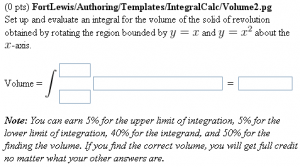Volume2
This problem has been replaced with a newer version of this problem
A Question with Weighted Answer Blanks and a Credit Answer
This PG code shows how to construct a volume of solids of revolution question that allows students to set up the integral and earn partial credit, or to answer just the final question for full credit.
- File location in OPL: FortLewis/Authoring/Templates/IntegralCalc/Volume2.pg
- PGML location in OPL: FortLewis/Authoring/Templates/IntegralCalc/Volume2_PGML.pg
| PG problem file | Explanation |
|---|---|
|
Problem tagging: |
|
DOCUMENT(); loadMacros( "PGstandard.pl", "MathObjects.pl", "PGunion.pl", "answerHints.pl", "weightedGrader.pl", ); TEXT(beginproblem()); install_weighted_grader(); $showPartialCorrectAnswers = 1; |
Initialization:
We load |
Context("Numeric");
Context()->variables->are(
x=>"Real", dx=>"Real",
y=>"Real", dy=>"Real"
);
$f = Compute("x");
$g = Compute("x^2");
$upper = Real("1");
$lower = Real("0");
# answers below are intentionally wrong
$int = Compute("( pi x - pi x^2 ) dx");
$vol = Compute("pi");
@weights = (5,5,40,50);
#
# Display the answer blanks properly in different modes
#
Context()->texStrings;
if ($displayMode eq 'TeX') {
$integral =
'Volume = \(\displaystyle' .
'\int_{'.
NAMED_ANS_RULE("lowerlimit",4). '}^{'.
NAMED_ANS_RULE("upperlimit",4). '}'.
NAMED_ANS_RULE("integrand",30). ' = '.
ans_rule(10).
'\)';
} else {
$integral =
BeginTable(center=>0).
Row([
'Volume = \(\displaystyle\int\)',
NAMED_ANS_RULE("upperlimit",4).$BR.$BR.
NAMED_ANS_RULE("lowerlimit",4),
NAMED_ANS_RULE("integrand",30).$SPACE.' = '.$SPACE.
ans_rule(10),
],separation=>2).
EndTable();
}
Context()->normalStrings;
|
Setup:
Notice that for the final answer (volume) we use |
Context()->texStrings;
BEGIN_TEXT
Set up and evaluate an integral for the volume
of the solid of revolution obtained by rotating
the region bounded by \( y = $f \) and \( y = $g \)
about the \(x\)-axis.
$BR
$BR
$integral
END_TEXT
TEXT(MODES(TeX=>"",HTML=>
"${PAR}${BITALIC}${BBOLD}Note:${EBOLD}
You can earn
$weights[0]${PERCENT} for the upper limit of integration,
$weights[1]${PERCENT} for the lower limit of integration,
$weights[2]${PERCENT} for the integrand, and
$weights[3]${PERCENT} for the finding the volume.
If you find the correct volume, you will get full credit
no matter what your other answers are.
${EITALIC}"));
Context()->normalStrings;
|
Main Text: In HTML mode, we add an explanation of how the question will be graded, pointing out that full credit can be earned if the volume calculation is correct. |
NAMED_WEIGHTED_ANS( "upperlimit" => $upper->cmp(), $weights[0] );
NAMED_WEIGHTED_ANS( "lowerlimit" => $lower->cmp(), $weights[1] );
NAMED_WEIGHTED_ANS( "integrand" => $int->cmp()
->withPostFilter(AnswerHints(
Formula("pi x - pi x^2 dx") => "Don't forget to multiply every
term in the integrand by dx",
Formula("pi x - pi x^2") => "Don't forget the differential dx",
Formula("(pi x^2 - pi x)*dx") => "Is the parabola above the line?",
Formula("pi x^2 - pi x") => "Is the parabola above the line?",
)),
$weights[2]
);
CREDIT_ANS( $vol->cmp(), ["upperlimit","lowerlimit","integrand"], $weights[3] );
|
Answer Evaluation:
Notice that we use |
Context()->texStrings;
BEGIN_SOLUTION
Solution explanation goes here.
END_SOLUTION
Context()->normalStrings;
COMMENT('MathObject version. Weights each answer blank separately,
and the last answer provides full credit for all other answer blanks.');
ENDDOCUMENT();
|
Solution: |
